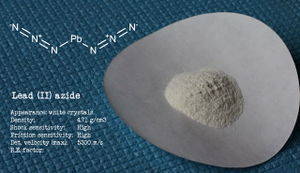Lead(II) azide
 Lead(II) azide powder
| |
| Names | |
|---|---|
| IUPAC name
Diazidolead
| |
| Other names
Lead azide
Bleiazid | |
| Properties | |
| Pb(N3)2 | |
| Molar mass | 291.24 g/mol |
| Appearance | White powder |
| Odor | Odorless |
| Density | 4.71 g/cm3 |
| Melting point | 190 °C (374 °F; 463 K) (decomposes) |
| Boiling point | (explodes at 350 °C) |
| 2.3 g/100 mL (18 °C) 9.0 g/100 mL (70 °C) | |
| Solubility | Very soluble in acetic acid Slightly soluble in alcohol and ether Insoluble in aqueous ammonia |
| Thermochemistry | |
| Std enthalpy of
formation (ΔfH |
462.3 kJ/mol |
| Hazards | |
| Safety data sheet | CPCB |
| Related compounds | |
| Related compounds
|
Sodium azide |
| Except where otherwise noted, data are given for materials in their standard state (at 25 °C [77 °F], 100 kPa). | |
| Infobox references | |
Lead azide is an inorganic compound with the formula Pb(N3)2. It is used as a primer in detonators to initiate secondary explosives, though it has been removed from most commercial detonators due to its toxicity.
Contents
Properties
Chemical
Gently heating lead(II) azide will give off nitrogen gas and leave behind pure lead. However, the decomposition is not as smooth as that of sodium azide, and may explode. If the decomposition takes place in air, lead(II) oxide will also form.
Physical
Lead azide is a white solid, poorly soluble in water and ammonia, but very soluble in acetic acid, more so if hot. It has a density of 4.71 g/cm3. Lead(II) azide decomposes at 190 °C and explodes if heated at higher temperatures.
Explosive
Lead(II) azide is very sensitive to shock and friction and can be easily set off by a strong impact or an open flame. Its detonation velocity is 5180 m/s.
Carbon dioxide increases its sensitivity, especially in the presence of moisture, by forming carbonic acid.
Availability
Lead(II) azide is not sold even by big chemical suppliers. Explosive companies will sell Pb(N3)2 detonators, but only if you have an explosive permit.
Preparation
Lead(II) azide can be prepared by adding an aqueous solution of lead(II) nitrate to a solution of sodium azide.
- Pb(NO3)2 + 2 NaN3 → Pb(N3)2 + 2 NaNO3
Due to its low solubility, lead azide precipitates out of the solution. The precipitate is filtered, washed with anhydrous ethanol and air dried.[1]
Dextrin is generally added as a stabilizer during synthesis, to inhibit the formation of large or needle-like crystals, which are very sensitive. Other compounds, like polyvinyl alcohol (PVA) can also be used.
Lead(II) acetate can also be used instead of the nitrate.
Projects
- Make blasting caps
Handling
Safety
Lead(II) azide is very toxic and should be handled with proper protection.
Lead azide can react with copper, zinc, cadmium to form their respective azides, which are even more sensitive. Contact with these metals must be avoided. Aluminium however does not react with Pb(N3)2 due to the formation of an oxide layer.
Storage
Lead(II) azide is best stored in rubber or wood containers, to avoid static discharges. Plastic or glass containers may not be suitable. Dextrin is used as a stabilizer.
Disposal
Nitrous acid can be used to destroy lead(II) azide. Ammonium acetate and sodium dichromate can also be used. Bleach also works.